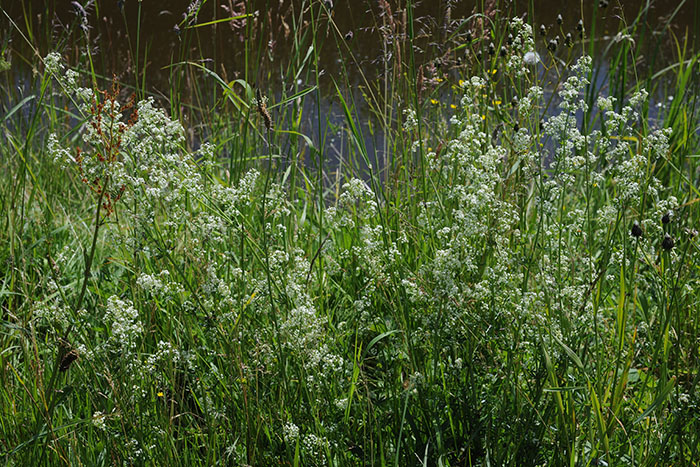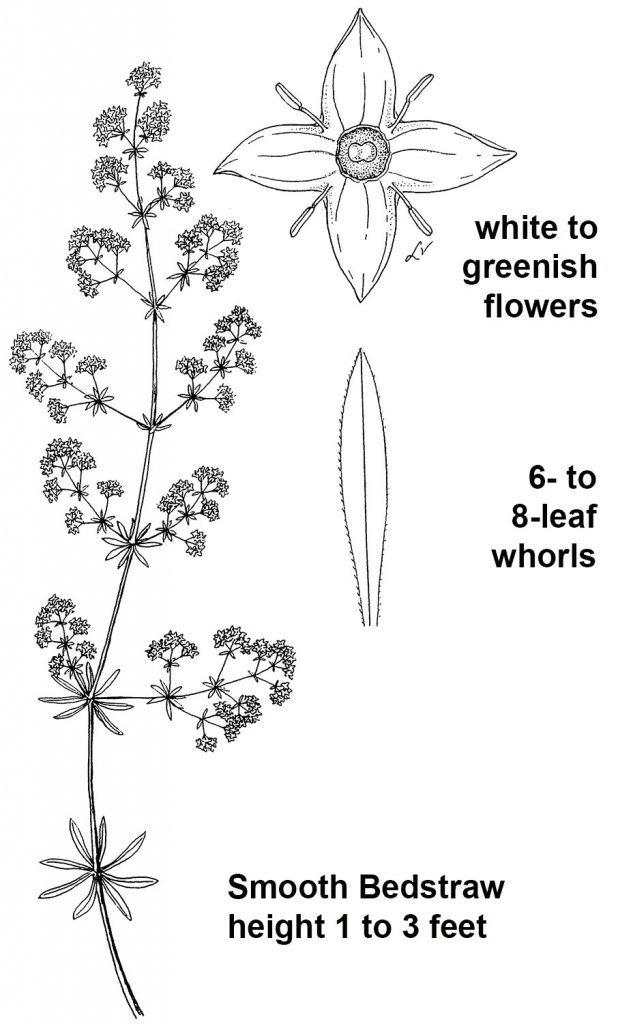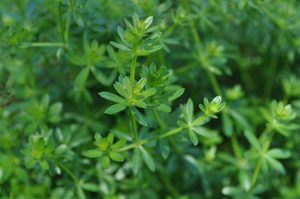Bulletin #2278, Controlling Smooth Bedstraw in Hayfields and Pastures
Originally developed by Extension Professor Richard Kersbergen, University of Maine Cooperative Extension.
Reviewed and updated by Jaime Garzon, Assistant Extension Professor and Dairy Forage Educator, University of Maine Cooperative Extension.
For information about UMaine Extension programs and resources, visit extension.umaine.edu.
Find more of our publications and books at extension.umaine.edu/publications/.
Table of Contents:

- Smooth Bedstraw
- Is It Smooth Bedstraw?
- Maine Research Trials in Controlling Smooth Bedstraw
- Supporting Data
- Table 1. Stem counts and mean total yield of forage and bedstraw (first-year study)
- Table 2. Stem counts and mean total yield of forage and bedstraw (second-year study)
- References
In late June and early July in New England we see many hayfields and pastures turn white. That white-flowering weed is most likely smooth bedstraw (Galium mollugo L.). This perennial weed is spreading at an alarming rate in hayfields and pastures throughout the Northeast, reducing the quantity and quality of your forage crop.
Smooth Bedstraw
Smooth bedstraw is an invasive and opportunistic weed. Its present area of adaptation ranges from southern Canada to as far south as Georgia. Historically, smooth bedstraw is first found in fields that have been poorly managed—hayfields with low fertility and high acidity (low pH), or pastures that have been continuously grazed or underutilized. As farm fields are either abandoned or less intensively managed, we see soils becoming acidic, with fertility dropping and smooth bedstraw proliferating. Smooth bedstraw tolerates low soil nitrogen and low pH better than our desired forage species. Lately, however, we have found smooth bedstraw to be invading better-managed stands of forages (long-term hayfields) and adapting to more variable environmental and soil conditions. Recently, it has been seen growing and thriving in a wide variety of conditions, including on lawns!


Is It Smooth Bedstraw?
Smooth bedstraw is a perennial broadleaf plant with numerous relatively upright stems, and it reproduces both vegetatively and by seed. It has a branching taproot and also produces woody rhizomes that spread horizontally, producing new stems and roots at their nodes. Smooth bedstraw produces white to greenish flowers that appear in late June and early July and has another flowering period in mid to late August. Individual plants can grow one to three feet tall and spread to three feet or more in diameter, with multiple stems. The plant produces numerous seeds that are easily spread by animals, wind, and rain, providing avenues for this problem weed to enter new fields. Bedstraw can also be spread when seeds are carried from field to field on mowing, baling, and tillage equipment. The “seed rain” will occur after each flowering period (July and August), with the new seedlings most often growing the following spring.
In contrast to the annual catchweed bedstraw (G. aparine L.), smooth bedstraw has an almost hairless, smooth stem (hence the name). Its leaf shape and leaf arrangement in whorls is typical for many bedstraw species (see illustration on page one). The leaves are less than one inch long and are arranged in six- or eight-leaf whorls. Smooth bedstraw differs from its close relative, the perennial northern bedstraw (G. boreale), which has four longer (one to two inches long) leaves to each whorl.
Smooth bedstraw can significantly reduce the yields of hayfields due to its competitive nature. The large-crowned plants quickly dominate fields of timothy, bluegrass, clover, and other cool-season forages. In pasture situations, livestock typically avoids bedstraw, adding to its ability to spread and dominate the forage stand. In New Brunswick, smooth bedstraw has been observed to eliminate 80 to 90 percent of the grass sward in pastures. Smooth bedstraw also contains some chemicals that further reduce forage quality by making it distasteful for animals.
How is Smooth Bedstraw controlled?
Cultural management
Providing the best growing conditions will help the desired forage plants compete effectively with bedstraw. That means supplying adequate nutrients and lime. Liming should raise the soil acidity to at least pH 6. Cutting the hay more than once during the growing season also keeps the forage grasses active and strong and will help control the weeds somewhat.
Grazing is not a good management strategy since livestock usually prefer the forage grasses over bedstraw. Consequently, grazing reduces the bedstraw’s competition, which allows it to spread.
An option for severe weed infestation is to take the field out of hay production for at least two years. The field should be plowed and then planted into a field crop or cover crop. Cultivated crops that form a dense canopy to keep the light from reaching the soil surface may reduce the germination of remaining weed seeds. Depending on the soil conditions, suitable crops include densely planted alfalfa, or cover crops such as buckwheat or sorghum-sudangrass hybrids.
Mechanical management
Mowing will reduce the vigor but not the number of established bedstraw because plants will just regrow due to the extensive energy reserves stored underground in roots and rhizomes. However, mowing before the bedstraw goes to seed will reduce the rate of spread in the field.
Tillage is a good management option because it effectively kills the plants. Tillage of course requires reseeding with hay or planting of another crop. Although expensive, this solution may be the only one that works in some situations.
Chemical management
Systemic herbicides can also be used to manage smooth bedstraw. Because of the weed’s large underground energy reserves, contact herbicides will provide only temporary control. Note that any effective herbicide will kill clovers and other legumes that many growers have in hay fields.
Maine Research Trials in Controlling Smooth Bedstraw
In 2004 and 2005, trials were conducted in Northport, Maine, to evaluate methods to control smooth bedstraw. The research site contained a stand of bedstraw that dominated the pre-existing forage sward.
Parameters and methods
Four methods of control were investigated in a replicated experiment to establish acceptable techniques for controlling this plant. Because smooth bedstraw is rarely found in fields that are intensively rotated between perennial forages and annuals (such as corn silage), the first treatment, a tillage treatment, included a cover crop of buckwheat followed by a bare fallow period during the summer to both kill perennial plants and deplete the weed-seed reservoir in the soil. A second treatment looked at using high rates of nitrogen fertilizer to see if the remaining grasses might be able to utilize the nitrogen and out-compete the smooth bedstraw (as smooth bedstraw is sensitive to shading). We also included a treatment using a systemic herbicide (glyphosate) to kill the bedstraw and the desirable grasses, and reseeded the plot with a no-till drill. This treatment would be applicable to the many fields and pastures in Maine located on shallow soils where tillage is not an option. The final treatment was a late-summer application of Crossbow herbicide (which is a combination of 2, 4-D ester and triclopyr) at three quarts per acre. In all of the treatments, we kept the bedstraw from going to seed during the treatment year. This turned out to be an important consideration in controlling the problem.
Results
The first line of control for smooth bedstraw is to keep the plant from going to seed for a year prior to any attempt to kill the perennial plants. This became very obvious to us from the treatment where we used glyphosate in the spring to kill all existing vegetation, and no-till drilled in new sod. In this treatment, while we eliminated the existing perennial crowns, we ended up with a new stand of bedstraw seedlings that dominated the new forage stand. Past research has found that smooth bedstraw seed that has dropped to the ground in July and August will germinate and grow the following spring, but will not remain viable for longer periods (Mersereau 2003). Therefore, one strategy for control would involve a two-year process, with the first year focused on eliminating seed rain by either clipping or using a burn-down herbicide, and the second year focused on killing the perennial plant with either tillage or systemic herbicides.
Although nitrogen fertilizer improved the grass growth and yield, the smooth bedstraw also responded with increased plant vigor. Over a longer period, nitrogen fertilization would likely begin to give the grasses a competitive advantage as smooth bedstraw does not tolerate shade very well.
Tillage, a bare fallow, and a buckwheat cover crop controlled both the perennial plant and the new seedlings as they emerged, as we would have expected. This may be the only option for control for organic growers.
The fall application (around late August or early September) of Crossbow also provided excellent control of the perennial plant. Please note that we did control the weed seed rain by mowing before flowering for the entire growing season before using this treatment—this is crucial to success.
IIn the spring of 2005, stem counts were taken in three subplots within each plot. There was an average of 41 bedstraw stems per square foot in the control plot. The nitrogen-amended plots averaged 47 stems and the glyphosate-treated/no-till plots averaged 80 stems per square foot. The tilled plots and the Crossbow-treated plots had 0 stems (See Table 1).
In the second year of the study, we replicated the first year’s trial but added a spring burn treatment where we burned the residual hay from the previous year and also controlled the seed deposition by mowing before flowering in the glyphosate-treated plots. The results indicate that the burning treatment had little impact on controlling smooth bedstraw and that by controlling seed deposition in the glyphosate-treated plots, we effectively managed the weed population. (See Table 2)
In later years two new herbicide products appeared on the market: Milestone and Forefront R&P, which have excellent efficacy against smooth bedstraw in field trials in New York and Pennsylvania (Curran 2007). The active ingredient is aminopyralid, which has a relatively low toxicity level. Milestone at four ounces per acre and Forefront R&P at both one-and-a-half and two ounces per acre provided 96 to 99 percent control of bedstraw in trials at Penn State University in both spring and late-summer applications. However, as with Crossbow, these herbicides also will eliminate all desirable broadleaf forages such as clovers and alfalfa that you may have in the fields.
It is highly recommended (and mandatory by law) to read and follow all label restrictions with any herbicide to use. Some of these products have grazing and/or harvest restrictions following application.
Supporting Data
These tables summarize the data collected from the 2004 and 2005 bedstraw control research trials in Northport, Maine.
References
Mersereau, D., and A. DiTommaso, 2003. “The biology of Canadian weeds. 121. Galium mollugo L.” Canadian Journal of Plant Science 83: 453-467.
2007 Cornell Guide for Integrated Field Crop Management. Edited by Russell Hahn. Ithaca, NY: Cornell University Cooperative Extension.
Seiter, Stefan, 2003. Managing Smooth Bedstraw in Forage Crops. University of New Hampshire Cooperative Extension.
Curran, W. Pennsylvania State University. (E-mail message to the author. Spring, 2007.)
Funding for this project was provided through a Partnership Grant from the Northeast Sustainable Agriculture Research and Education Program (NESARE ONE04-025).
Brand names and trade names are included for educational purposes. No endorsement is implied nor is discrimination intended against similar products or services.
Information in this publication is provided purely for educational purposes. No responsibility is assumed for any problems associated with the use of products or services mentioned. No endorsement of products or companies is intended, nor is criticism of unnamed products or companies implied.
© 2008, 2024
Call 800.287.0274 (in Maine), or 207.581.3188, for information on publications and program offerings from University of Maine Cooperative Extension, or visit extension.umaine.edu.
In complying with the letter and spirit of applicable laws and pursuing its own goals of diversity, the University of Maine System does not discriminate on the grounds of race, color, religion, sex, sexual orientation, transgender status, gender, gender identity or expression, ethnicity, national origin, citizenship status, familial status, ancestry, age, disability physical or mental, genetic information, or veterans or military status in employment, education, and all other programs and activities. The University provides reasonable accommodations to qualified individuals with disabilities upon request. The following person has been designated to handle inquiries regarding non-discrimination policies: Director of Institutional Equity and Title IX Services, 5713 Chadbourne Hall, Room 412, University of Maine, Orono, ME 04469-5713, 207.581.1226, TTY 711 (Maine Relay System).

